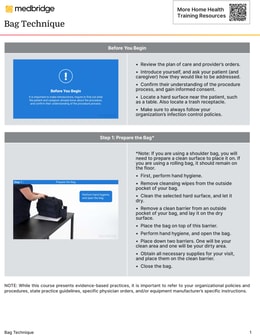Bag Technique Home Health: Evidence-Based Practices and PDF Reference
October 14, 2025
9 min. read

In home-based care, the bag technique is a structured method for organizing, staging, and decontaminating a clinician’s supply bag so it never becomes a vehicle for cross-contamination between homes. When done well, it supports safer visits, cleaner workflows, and survey-ready documentation.
In this article, we explain what bag technique in home health involves, why it matters, and how to apply it effectively in daily practice. You’ll learn the key principles, see a practical example, and find guidance for creating a bag technique home health PDF checklist that aligns with your organization’s policies.
Quick framing: bag technique within infection prevention programs
Bag technique is one component of a broader infection prevention framework that includes standard precautions, hand hygiene, cleaning and reprocessing of reusable equipment, and the use of transmission-based precautions based on risks present in the home. In the field, it bridges policy and practice, translating infection-control standards into simple, repeatable steps that fit the realities of home visits.1
Bag Technique
Submit a few brief details to unlock your free Bag Technique guide!

Why a bag technique in home health matters
Home visits move fast. Between travel, documentation, and patient care, it’s easy for the clinician’s bag to become an afterthought. A single contaminated surface can carry microorganisms from one home to another, putting both patients and staff at risk. That’s why maintaining a consistent technique isn’t just a formality—it’s a frontline defense against infection.
Here are a few key reasons this practice remains essential across every home visit:
Bags can act as fomites. Studies in home health settings have found bacterial contamination on nursing bags and patient-care equipment stored inside them, showing how easily microorganisms can spread between homes when workflows are inconsistent.2,3
Regulatory alignment. Accrediting bodies and Conditions of Participation require agencies to maintain infection prevention programs that protect patients, families, and staff. The bag technique in home health helps put those standards into action during every visit.4
Current guidance. National home care practice resources continue to emphasize bag technique home health as part of standard precautions, reinforcing its role in maintaining safe, consistent care across visits.
Core principles for effective bag technique
Consistency turns bag technique from a checklist into a habit. Every home visit follows its own rhythm, but the same infection prevention principles should guide each one.
These core practices outline what effective bag technique in home health looks like in action:
Hand hygiene anchors every step
Perform hand hygiene before accessing the bag, after handling soiled items, and before exiting the home. Use alcohol-based hand rub when hands are not visibly soiled; use soap and water when visibly soiled or dealing with specific pathogens.1
Designate “clean” and “dirty” zones
The bag represents a clean zone. Anything that has contacted the patient or home environment is contaminated until cleaned and reprocessed. Never return used items to clean compartments without disinfection.
Stage the bag on a barrier
Place the bag on a clean, dry surface covered with a disposable barrier or cleanable hard surface.2 Avoid floors, upholstered furniture, beds, or kitchen counters. A dedicated staging area helps maintain a defined clean zone, even in unpredictable environments.
Plan ahead
Limit entries into the bag. Pre-plan the visit, remove only what’s needed, and close the bag promptly to maintain a clean environment. Taking a moment to plan prevents unnecessary cross-contamination and saves time during the visit.
Disinfect at point of use
Clean reusable equipment before returning it to the bag’s clean compartment, following manufacturer instructions for contact time and disinfectant type.4
Escalate when necessary
For pathogens with higher transmission risk, follow transmission-based precautions: leave certain supplies outside the home, use single-patient items when possible, and wear appropriate personal protective equipment (PPE).5
Example: applying bag technique in a home health visit
Now let’s see what these principles look like in action. The example below walks through a home health nursing visit where bag technique supports safe, efficient care.
Here’s the scenario: A home health nurse is conducting a 30-minute visit for a patient with a chronic lower-extremity wound. The goals include assessing vital signs, reviewing medications, and performing a wound reassessment and dressing change.
The visit unfolds in six stages, from preparation to exit, each guided by best practices.
1. Before entering the home
Perform hand hygiene using an alcohol-based hand rub (ABHR) before entering the home (ABHR preferred when hands aren’t visibly soiled).1
Confirm all needed supplies are stored in the bag’s clean compartments.
If the home has a pest infestation or known high-risk organism, adapt: bring only disposable supplies in a secondary container and leave the main bag in the car if necessary.
2. Upon entry and staging
Ask for a clean, dry, low-traffic surface. If a clean surface isn’t available, create one with a disposable barrier and keep the bag zipped when not in use.
Perform hand hygiene before opening the bag.
3. Setting up supplies
Remove only clean items needed for the visit, placing them on a separate clean field.
Put on PPE based on anticipated exposure (e.g., gloves for wound care).
4. Care activities
Complete assessments and procedures. If moving from a contaminated to a clean task, change gloves and perform hand hygiene.
Dispose of used items in a lined receptacle or patient waste stream per policy. Place sharps in a portable container—never return them to the clean bag.
5. Breakdown and reprocessing
Disinfect reusable equipment for the labeled contact time before returning to clean compartments.1,5
Wipe the exterior of the bag if contamination is suspected.
Remove and discard the barrier, perform hand hygiene, and zip the bag closed.
6. Exit
Perform hand hygiene at exit and again at the vehicle.
Secure and dispose of waste according to policy.
Following this sequence ensures each visit starts and ends with the same safe, consistent workflow.
The evidence behind effective bag technique
Research shows that nursing bags can harbor microorganisms, turning an essential clinical tool into a potential source of cross-contamination if not handled carefully. One frequently cited study found microbial contamination inside home health nursing bags and on the equipment stored within them, reinforcing why the bag must be treated as a clean zone—protected with barriers, limited access, and point-of-use disinfection.2,3
Practice articles and implementation resources echo those findings. They emphasize zoning, staging the bag on barriers, and limiting entries to reduce microorganism transfer during multi-home visits.2
These same strategies align with the CDC’s standard precautions and core infection prevention and control practices, which apply to all care settings and emphasize hand hygiene, PPE use, and reprocessing of reusable equipment.
Finally, accrediting bodies and the Conditions of Participation connect these best practices to agency-wide infection prevention programs—linking consistent technique, documentation, and staff training to safer, more reliable care.4
Common pitfalls and how to avoid them
Even with the best intentions, maintaining perfect technique in every home can be challenging. Space constraints, patient needs, and time pressure can lead to shortcuts that increase infection risk. Recognizing where bag technique often breaks down—and how to prevent those lapses—helps clinicians stay consistent without adding extra complexity to the visit.
Here are some common pitfalls and practical ways to avoid them:
Placing the bag on a bed, couch, or floor: Always use a barrier on a stable, cleanable surface.2,3
Re-entering the bag with contaminated gloves: Perform hand hygiene and re-glove before accessing clean compartments.
Rushing equipment reprocessing: Always disinfect and respect labeled contact times.
Using shared stethoscopes in higher-risk cases: Follow transmission-based precautions and dedicate patient-specific equipment when possible.
Skipping documentation: When alternative staging is needed due to space or contamination risk, document your rationale and educate the patient or family.4
Implementation tips for agencies
Consistent bag technique doesn’t just depend on individual clinicians—it requires organizational support. Clear policies, standardized equipment, and ongoing training make it easier for staff to apply infection prevention best practices in the field. These strategies help agencies operationalize compliance while building a culture of safety and accountability.
Standardize the bag: Choose models with labeled clean compartments and easy-to-wipe exteriors. Include barriers and sharps containers in issued kits.
Train and validate: Teach key hand hygiene moments, zoning, and reprocessing. Validate competency on hire and during annual reviews.4
Audit regularly: Use short observational tools during ride-alongs or self-audits. Track results within QAPI programs to monitor consistency.4
Keep resources updated: Review your bag technique home health PDF regularly to ensure disinfectants, contact times, and policies align with current evidence.
Bag technique in home health: from principle to practice
Bag technique transforms infection prevention from policy into everyday practice. When clinicians follow consistent habits such as hand hygiene, zoning, staging, and reprocessing, each visit becomes safer and more predictable for both patients and staff.
By supporting these efforts with clear training, regular audits, and an up-to-date bag technique home health PDF checklist, agencies can turn small, consistent actions into lasting improvements in safety and quality.
You can also access more procedures in the Medbridge Clinical Procedure Manual, an on-the-go resource with expert-reviewed instructions, safety checks, and video demonstrations to support home health clinicians at the point of care.
References
Centers for Disease Control and Prevention. (2024, April 12). CDC’s core infection prevention and control practices for safe healthcare delivery in all settings. https://www.cdc.gov/infection-control/hcp/core-practices/index.html
McGoldrick, M. (2017). Best practices for home care “bag technique” and the use of surface barriers. Home Healthcare Now, 35(9), 478-484. https://journals.lww.com/homehealthcarenurseonline/fulltext/2017/10000/best_practices_for_home_care__bag_technique__and.3.aspx
McGoldrick, M. (2025). Bag technique: Best practices for managing the home care bag [PDF]. Home Healthcare Now. https://nursing.ceconnection.com/files/BagTechniqueBestPracticesforManagingtheHomeCareBag-1736692015355.pdf
Litwin, S. M., & McGoldrick, M. (2022). Infection control policies & procedures in home health & hospice [PDF]. ACHC. https://www.achc.org/wp-content/uploads/2022/04/10552-infection-control-policies-and-procedures-in-home-health-hospice-final.pdf
Centers for Disease Control and Prevention. (2024, April 3). Standard precautions for all patient care. https://www.cdc.gov/infection-control/hcp/basics/standard-precautions.html






